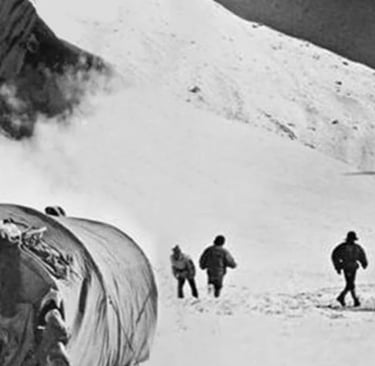Peak of Shadows: A Nuclear Secret buried in Nanda Devi
ESPIONAGE
Sahil Sharma
11/5/20233 min read


In the aftermath of India's triumphant ascent of Mt Everest in 1965, the celebration at Palam airport in Delhi was a spectacle of joy and achievement. The leader of the expedition, Manmohan Singh Kohli, basked in the adulation as dignitaries awaited the returning heroes. Little did he know that a clandestine mission was about to alter the course of history.
As Kohli descended the stairs, a surprise awaited him – Rameshwar Nath Kao, the director of the Aviation Research Centre, awaited him. What he anticipated to be a moment of praise turned into an unexpected turn of events. Kao entrusted Kohli with a top-secret mission: to plant a spying device on a mountain peak and monitor China's activities during the height of the Cold War.
The geopolitical backdrop was tense. The United States and China were embroiled in a strategic rivalry, and the Himalayas emerged as an unexpected theater for intelligence gathering. The idea of using the towering peaks for espionage found its genesis in a casual conversation between American mountaineer-photographer Barry Bishop and US Air Force Chief of Staff Curtis LeMay.
The plan initially aimed for Mt Kanchenjunga but logistical challenges redirected their attention to Nanda Devi. The mission involved carrying a spying device, fueled by radioactive plutonium, to the summit. The device, officially known as SNAP 19C (System for Nuclear Auxiliary Power), was a thermoelectric generator capable of 40 watts of continuous output for two years. It derived its power from the heat generated by radioactive decay and was designed for use in remote, unattended locations.
In the thin atmosphere, the challenges became apparent during a practice run in Alaska. The device, composed of metal boxes labeled B1 and B2 acting as transceivers, a collection antenna, and the thermoelectric generator, proved cumbersome. The climbers, handpicked Indians and Americans, realized the difficulty of carrying the extra load, with assembly taking about an hour.
The journey to Nanda Devi was not just a mission; it was a logistical nightmare. The treacherous approach route through the Rishi Ganga gorge, flanked by double concentric mountain ranges, added layers of complexity. This formidable mountain, revered as a goddess by locals, demanded respect and presented challenges at every turn.
The team, unaware of the device's composition, ascended the peak, unaware of the risks involved. It wasn't until later that Kohli learned about the radioactive nature of the plutonium-fueled generator. The decision to abandon the mission and stash the device on the mountain, exposed to the harsh Himalayan elements, set the stage for a mystery that would endure for decades.
The next year, undeterred by the previous setback, a team comprising a few Indians from the initial expedition and an American nuclear expert returned to Nanda Devi. Lessons learned from the failed attempt prompted a strategic shift - instead of attempting to summit Nanda Devi again, they decided to retrieve the device and relocate it to the neighboring Mt Nanda Kot (6,861 meters).
The treacherous terrain and unpredictable weather conditions added to the complexity of the mission. As they ascended Nanda Devi to Camp 4 (7,239 meters), where they had stashed the device the previous year, shock awaited them - the device was nowhere to be found.
Subsequent attempts to retrieve the device proved futile. The mystery deepened, and concerns about potential radioactive contamination heightened. The missing device became a global puzzle, and the 1978 revelation in Outside magazine added an extra layer to the saga.
The whereabouts of the missing spying device still remain elusive, raising ethical and ecological questions about potential environmental risks. It is assumed that plutonium devices used in the generator got separated from their steel protection. In this mission, Plutonium Pu238 was used whose half-life or radioactive isotope to decay is around 88 years which means around 30-35 years are still left. Calls for modern technology to unveil the truth underscore the necessity for collaboration between Indian and American authorities.
